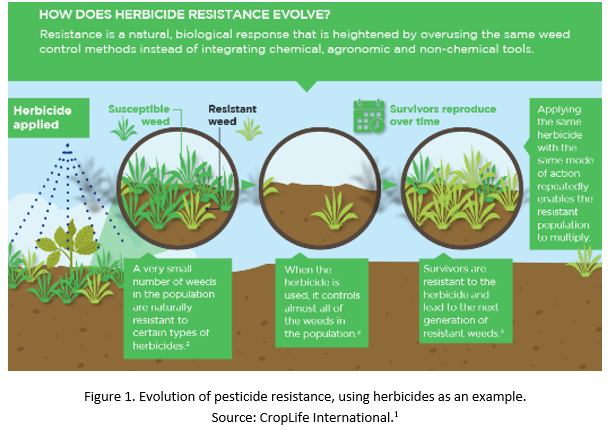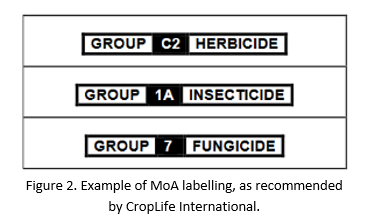Agrochemicals
Pesticide labelling initiative to help fight pest resistance 24th April 2018
By our Editorial Team
We look at recent efforts, driven by industry, to tackle the rise of pest resistance through improvements in product labelling, an
We look at recent efforts, driven by industry, to tackle the rise of pest resistance through improvements in product labelling, and subsequent smarter use of pesticides by farmers.
In a recent announcement, CropLife International – the voice of the global plant science industry – and its member companies made a voluntary commitment to include mode of action (MoA) information on all pesticide product labels by 2023.1 Currently, MoA labelling is only a regulatory requirement in a small number of countries, but CropLife International is encouraging authorities around the world to require mandatory labelling. Separately, it is encouraging pesticide manufacturers to follow its lead with voluntary labelling.
The move is intended to help fight resistance to crop protection products – a common, extensive and increasing problem faced by farmers across the world. In summary, a very small number of pests (insects, weeds, pathogens) in any population are likely to be naturally resistant to certain type of pesticide. Even if the pesticide controls almost the entire population at first use, survivors reproduce over time, leading to the next generation of resistant pests. At this point, the pesticide – and any others with a similar MOA – will cease to be effective (Figure 1).

Growing crops today frequently requires the combined use of novel crop protection products, transgenic plants and integrated management techniques. Effective integrated pest management (IPM) programmes, which may can prevent or delay resistance, include the use of synthetic insecticides, biological insecticides, beneficial arthropods, cultural practices, crop rotation and pest-resistant crop varieties.
And while it is recognised that applying the same pesticide with the same mode of action repeatedly enables the resistant population to multiply, so it is realised that sequential applications or applying mixtures of products with different, effective MoAs is a key strategy to delay the onset of pest resistance. This strategy is driving recent calls for MoA information on product labels. The inclusion of this information would ensure growers have simple access to critical information to support the implementation of resistance management.
“CropLife International and its members are taking the lead to proactively address the problem of resistance to crop protection products,” said Andy Ward, CropLife International Stewardship Director, in a recent statement to the press. “The inclusion of MoA information on product labels, supported by training and other resources, is critical to ensure growers have the information they need to follow resistance management guidelines and grow a healthy crop.”
To support the initiative, CropLife International developed labelling guidance which provides a clear and simple method to inform pesticide retailers and users the type of pesticide and its MoA group. These groups can be used to identify products with the same MoA – to discourage pest resistance, these should not be used sequentially or repetitively.

Practical recommendations for MoA labelling include:2
- Display the MoA icon in a prominent position on the label
- Use a clearly defined font, and a black and white colour scheme
- Use the word GROUP in black font on a white background, and the MoA letter or numeral in white font on a black background, within black rectangles (Figure 2)
- When the icon is printed on small packets, it must be clear
- The words GROUP and HERBICIDE, FUNGICIDE or INSECTICIDE should not be less than one-quarter of the height of the largest letter or numeral on the label, and be between 2 mm and 12.5 mm high
- Labelling should consider FAO/WHO Guidelines on Good Labelling Practice for Pesticides.
Coding of Insecticide MoA should be defined using the Insecticide Resistance Action Committee (IRAC) numeric group from www.irac-online.org. Fungicide MoAs should be defined using the Fungicide Resistance Action Committee (FRAC) numeric group from the annually updated list on www.frac.info. Herbicide MoAs should be defined using the Herbicide Resistance Action Committee (HRAC) numeric groups from the annually updated list on http://hracglobal.com.
As demands on the agricultural industry are predicted to increase in coming decades, in parallel with the expanding global population – and their expanding appetites, in parallel with rising middle classes and incomes in emerging markets – the issue of pesticide resistance is not something that any of us can afford to ignore. It behoves all of us in the industry, at all levels, to contribute to the discussion surrounding resistance, and raise awareness of the steps that can be taken to address it.
Speciality chemical manufacturers in the agrochemicals space can contribute enormously to this effort by updating their labels to include MoA information in a transparent, comprehensive and consistent manner. As industry bodies continue to lobby regulatory authorities to require this information in the future, responsible companies complying with this suggestion voluntarily now will demonstrate corporate responsibility and will help to combat this common, extensive and increasing global problem.
Reference
1. CropLife International. Press release, 8th March 2018 (https://t.co/X18xKQ35Up)
2. CropLife International. Mode of Action Labelling Guidance, March 2018.
1. CropLife International. Press release, 8th March 2018 (https://t.co/X18xKQ35Up)
2. CropLife International. Mode of Action Labelling Guidance, March 2018.



